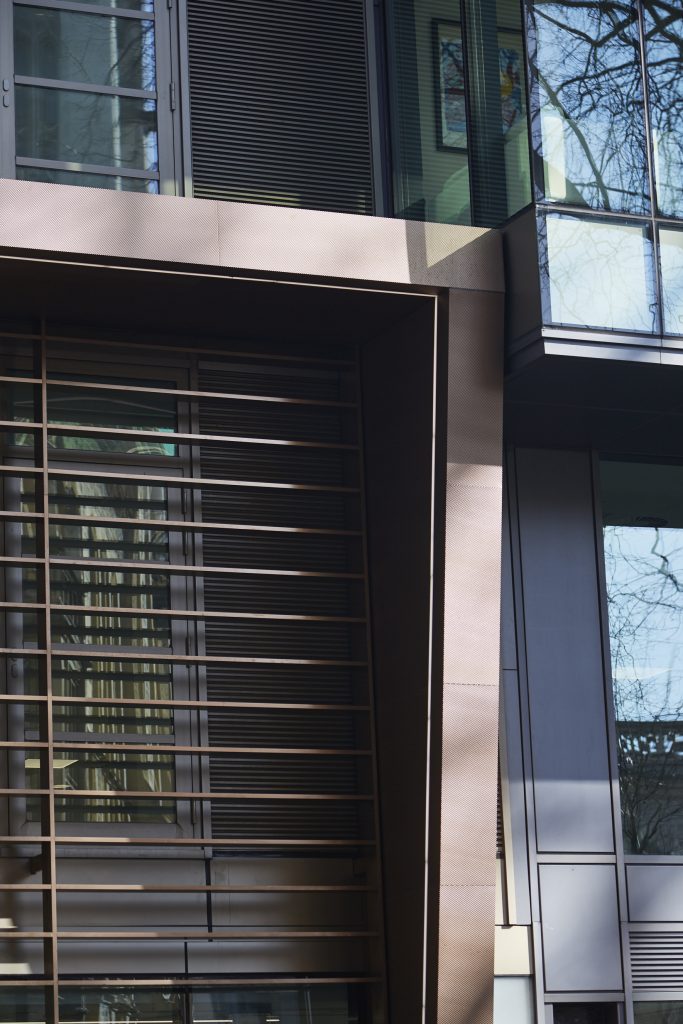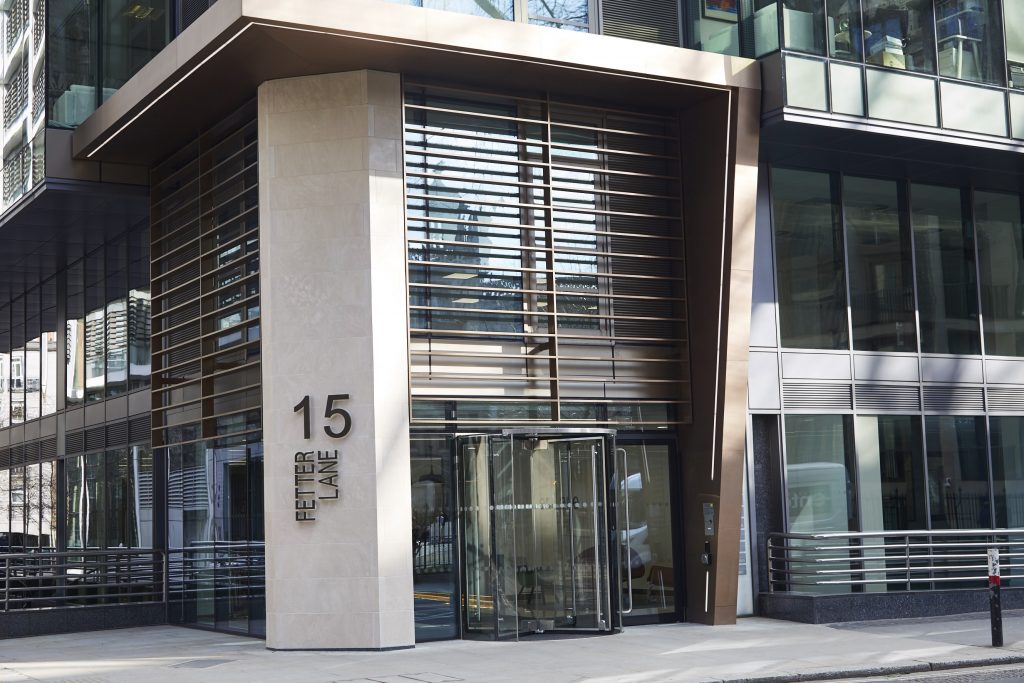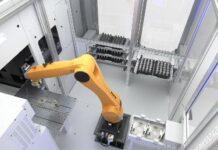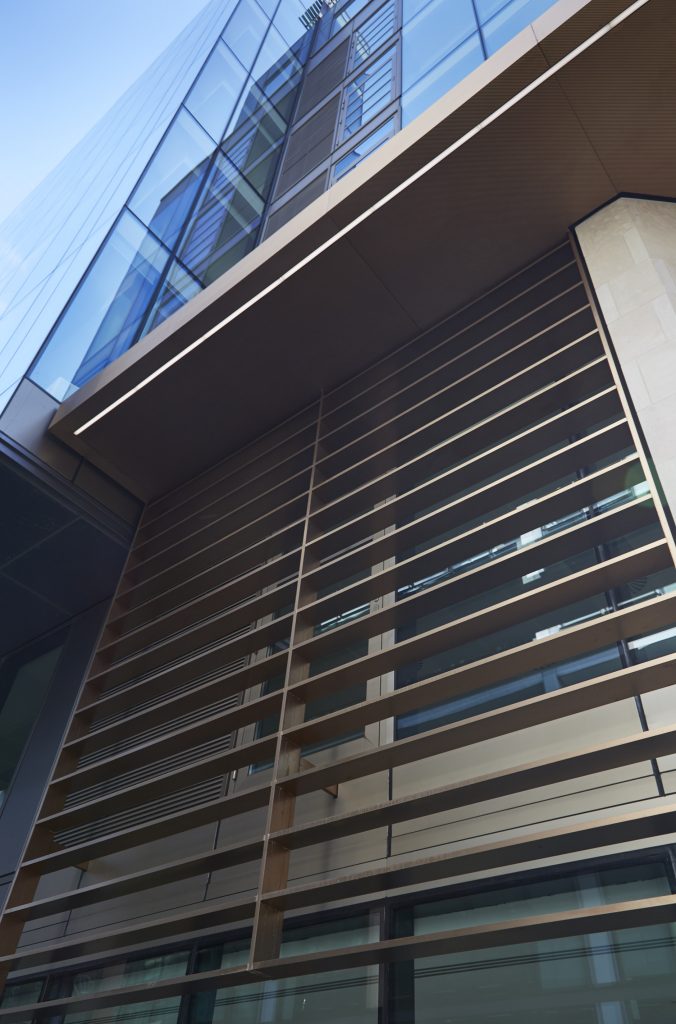 Creative designs are the prominent focus in the field of Architectural Metals. The designers are artists driven by their imagination and vision. They create eye catching art forms which make the buildings they design become landmarks with distinctive new features inside and out.
Creative designs are the prominent focus in the field of Architectural Metals. The designers are artists driven by their imagination and vision. They create eye catching art forms which make the buildings they design become landmarks with distinctive new features inside and out.
Stainless steel and Aluminum include many of today’s buildings and the curtain wall design utilizes panels made of various materials. Currently there is a new trend where these panels and interior components have new colors and textures. The color of stainless steel is created by a process known as PVD coating. Physical Vapor Deposition coatings produce thin films and coatings typically for thin mechanical, optical, chemical, or electronic functions. The range of colors of the coating offers new opportunities for designers to express themselves.
“The original brief was to undertake renovations to dilapidations as the main tenant was moving out of the building,” says Elizabeth Humphries, Associate Director Architecture at McBains. “Then we were asked to provide architectural services to refresh all the internal common parts and a concept design for the external entrance.
“The existing entrance was low and dark and not very discernible from the main thoroughfare as the entrance was at the side of the building. The client wanted to create a clear entrance that was welcoming and that had more gravitas and appeal.
There are some very smart façades along this stretch with some buildings having cathedral-like reception areas. Our design is intended to give the impression of a double height reception even though it is single height. We created a design that unified the façade at ground and first floor levels to give the impression of a more impressive space within.”
Challenges
There were quite a few challenges on the project. Firstly nothing was known about the structure of the façade of the building, as there were no detailed records or drawings. Assumptions were made as to what would be found once the existing façade was stripped off. These assumptions proved entirely false as the slab edge was much further back than assumed.
“So the project was structurally challenging,” explains Humphries. “Another challenge was that we had to fix the canopy whilst the tenants were in situ whilst we were working. Also there were a lot of trades people involved which meant a huge amount of co-ordination. There were curtain wallers, people replacing the glazing, revolving door fabricators and installers and stone masons who constructed the stone column.’
The Exterior Specification
Originally much brighter finishes were proposed, i.e. a powder-coated polyester canopy but the planners were not in favor as there is a listed building opposite and the bright finish was deemed to be unsuitable to be in such close proximity.
“We had to consider a more traditional finish,” says Humphries. “We looked at a bronze-colored material, Granex 6WL electro-plated and sandblasted stainless steel that had been used elsewhere to good effect and it had the really contemporary feel that we wanted. However we were really concerned that the electro-plated finish would be adversely affected by weather and we could not obtain a guarantee from the manufacturer.”
PVD Stainless Steel As A Finish
Alex Pashouros, project manager at John Desmond Ltd, proposed PVD as an alternative this proved more than acceptable as it had both the aesthetic appeal of bronze and also had a twelve-year guarantee which gave us and the client much-needed reassurance. The V-Grooving and folding of the PVD stainless steel sheet would achieve the look of solid bronze without the weight and was approved by the planning council.
Creating Desirability with a Contemporary Facade
The building really needed a strong identity as it was dated and lacked visual impact when viewed from the thoroughfare. The design of the brise soleil, canopy and column was developed to create a sense of presence and to bring the building into the 21st century in terms of style and materials. The re-orientation of the entrance to Fetter Lane and away from the side again gives the building greater appeal and is much more inviting.
The original specification for the brise soleil fins was for solid stainless steel bar so it was clear that the architect wanted the substantial look that of solid material. The issues with using solid stainless steel were that it would have been very heavy to hang from the canopy and the fins would have deflected under their own weight. As this would have still needed to be clad to achieve the bronze look it would have been an expensive exercise in terms of achieving the finish and attaching such a weighty structure to the building.
“We were keen to offer an alternative that had the same substantial appearance,” explains Pashouros, “but that would be much lighter and a lot less expensive to produce both in terms of the material and the structural labor.”
Replicating solid stainless steel
The solution that Pashouros and the John Desmond Limited team felt was both cost-effective and aesthetically a perfect match was to fabricate the brise soleil, canopy and column from PVD colored stainless steel. This would then be V grooved and folded to appear as solid material.
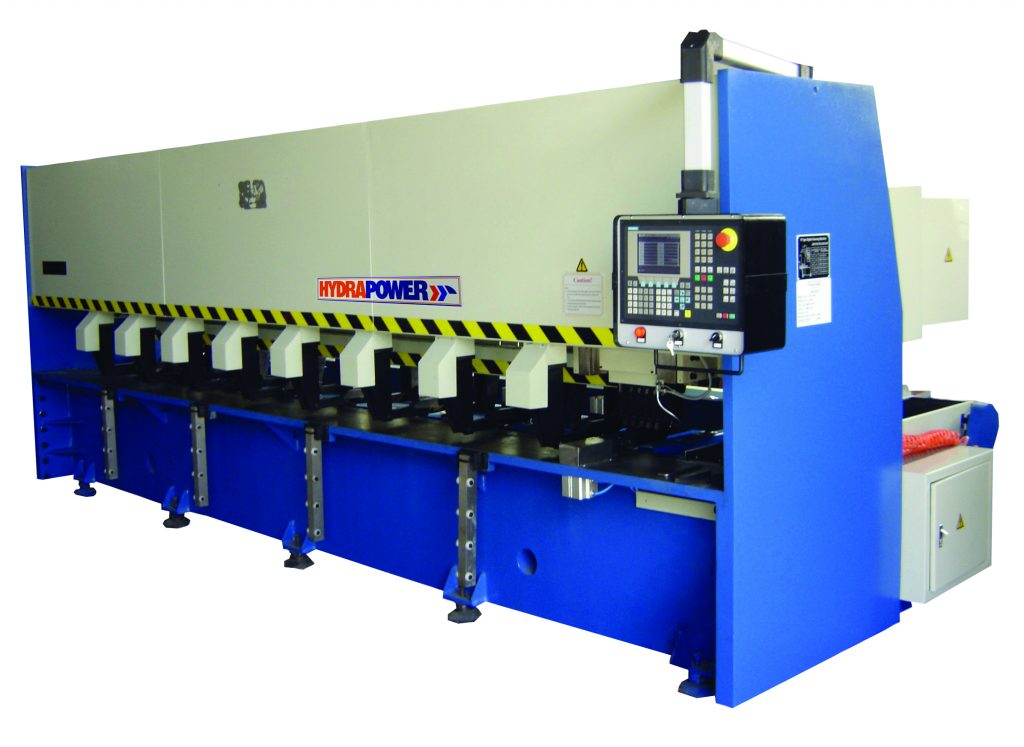 The technology behind V Groovers enables sheet metal to be formed with a sharp outside corner on the bend. Early versions of V Groovers had a limited capacity and most were capable of only 3 or 4mm thickness and most frequently they grooved thin decorative stainless steel. Some V Groovers are in fact modified planers, while some are like routers. V grooving is also processed on milling machines.
The technology behind V Groovers enables sheet metal to be formed with a sharp outside corner on the bend. Early versions of V Groovers had a limited capacity and most were capable of only 3 or 4mm thickness and most frequently they grooved thin decorative stainless steel. Some V Groovers are in fact modified planers, while some are like routers. V grooving is also processed on milling machines.
Typically, a V groove is machined on the inside of the bend line and when the metal was bent along that line a sharp corner is achieved. This sharp corner is required by architectural designers who want buildings to have a distinctive, high quality look and precision fit. The design’s overall focus is on visual appeal, and not related to structural strengths.
Advancing Grooving Technology
The early designed machines continue to offer the limited capacity and performances but Hydrapower International, Inc. embarked on a five year product development mission. The Florida based manufacturer of bending, shearing, pole manufacturing, punching, and cutting solutions, advanced grooving technology to meet the increasing demands of architectural designers. Hydrapower’s Groovers can accommodate sheets up to ½” thick and 20′ long.
“Their current performance now has almost obsoleted the name,” explains Rob Wissing, president of Hydrapower International, Inc. “These machines make a large range of grooves other than Vees and could be more aptly called Groovers.”
A V Groover can finish a 10′ x 0.045″ deep groove in 16 gauge stainless steel in about five seconds. A complete panel with four grooves at 10′ long will be processed in a cycle time of about one minute. With Hydrapower’s software, a “pause” function can be activated to automatically bring the sheet to the front where the clamps will release and the operator can turn it 90 degrees to run grooves in the perpendicular direction. This feature is also used when a sheet is grooved on both sides.
Modular Build Off-Site To Reduce Risk
There were challenges on the project as the John Desmond team couldn’t have free access as the remaining tenant had sensitive legal documentations in its care. All work had to be carried out from the outside of the building other than two weekends, and their normal access to the building interior was via scaffolding that was wrapped around the outside. With such restricted timescales and access it was essential that whilst on-site all construction work proceeded smoothly and without any delays.
“Building off-site was the only way to approach this project,” explains Pashouros. “By completely building the structures off-site this reduced the risk of on-site delays and disruption. All components were fabricated in our workshops which allowed the structures to be inspected by the design team and the contractors.”
The architect’s design enabled the canopy to be made off-site. The cladding was clipped on using bespoke clips in the workshop and then dismantled into as few sections as possible. This process meant that all the clips and sections were in the right places and the on-site process was greatly simplified. A hoist on site was to lift each section into position however its weight restriction was 250kg. The canopy structure was transported to site in 26 sections each weighing 150kg.
The brise soleil was built to its full height of four meters in the workshop, then dismantled and taken to site. The verticals were solid with aluminum inserts clad in the PVD sheet. The fins were created from the PVD sheet and strengthened with stainless steel ribs which were bonded on together with the end caps. The column, however was six meters high so had to be built in two sections. It was laid down on its back and the whole column clad in the workshop before being dismantled and taken to site.
For the brise soleil, canopy and column 45 sheets of 2.4 by 1.2m 316 1.5mm stainless steel were used with the sheets coloured through the PVD process and then embossed. Fabrication time was four weeks and the installation time eight weeks.
Commercial success
“We have worked with the client a few times but not to this extent,” says Elizabeth Humphries. “This was our largest project with them to date. The client was thrilled with the result. Why? They pre-let one of the floors whilst the work was still going on and quickly had considerable interest in the other floors. They have also significantly increased the rent charged on the spaces.”
About Hydrapower International, Inc.
There are around 4000 Hydrapower machines in use throughout the world and rarely will you find a used machine for sale. Since 1972, Hydrapower has invested in engineering and customer service. All of their machines are built to quality standards much higher than ISO-9000 requirements and always have been.
About John Desmond Limited
John Desmond Ltd is a designer, fabricator and installer of specialist architectural metalwork. They work on projects where exceptionally high standards of architectural detailing are critical and are proud to have successfully developed working relationships with architects, designers and other contractors over our 46 years of trading.









